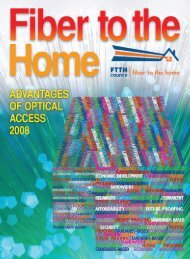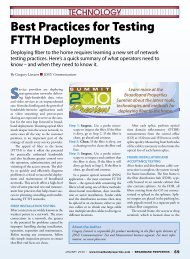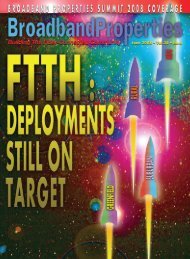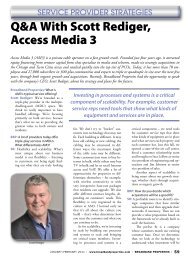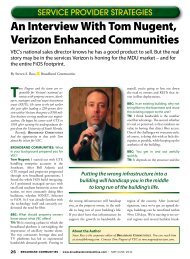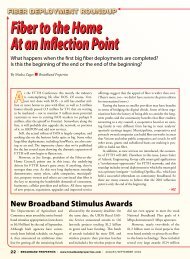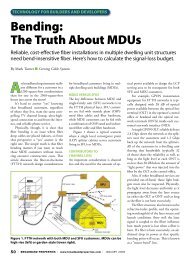bbpmag.com - Broadband Properties
bbpmag.com - Broadband Properties
bbpmag.com - Broadband Properties
Create successful ePaper yourself
Turn your PDF publications into a flip-book with our unique Google optimized e-Paper software.
editor’s note<br />
Learning from the <strong>Broadband</strong><br />
Ambush at Stimulus Gulch<br />
By Steven S. Ross ■ Editor-in-Chief<br />
It helps to know who your friends are<br />
– and how few understand the stakes<br />
involved in adding broadband to the<br />
stimulus package. As this went to press,<br />
the package had passed the House and<br />
was moving toward a final Senate vote.<br />
The $6 billion voted by the House had<br />
ballooned to as much as $9 billion in the<br />
Senate bill, but stood at $7.1 billion as<br />
we went to press.<br />
A late February 6 agreement among<br />
senators negotiating the stimulus package<br />
allocated $6.65 billion to broadband<br />
investments and $350 million to broadband<br />
mapping.<br />
One would have expected fairly clear<br />
sailing on the merits. But money devoted<br />
to broadband – less than 1 percent<br />
of the total, and one of the few items in<br />
the package that actually looks toward<br />
the future, rather than patching the past<br />
– had be<strong>com</strong>e a special target thanks<br />
mainly to well-placed public relations<br />
barbs launched by some incumbents.<br />
Republicans took advantage of that<br />
opposition. The Republican leadership<br />
in the Senate wants the stimulus package<br />
to be mainly tax relief for big business.<br />
They argue that too much of the<br />
Democrats’ plan depends on public<br />
works funding that may take months or<br />
years to “stimulate” anything. The Democrats<br />
reply that their plan includes $400<br />
billion in fast-acting tax cuts, and that<br />
much of the rest shores up state finances<br />
to keep police and teachers employed.<br />
Honest people can disagree. But how<br />
does one respond to the nonsense about<br />
broadband in the House Republicans’<br />
press release attacking the plan House<br />
Republican leader John Boehner (R-<br />
Ohio) said he used information provided<br />
by Senate Republicans for this line:<br />
In its haste to spend taxpayer money,<br />
the bill is rife with potential for waste.<br />
For example, it contains $350 million<br />
to map the current condition of the nation’s<br />
broadband network and to determine<br />
what areas need broadband.<br />
But it also contains $7 billion to begin<br />
constructing broadband infrastructure<br />
without any map or plan.<br />
Professionals in our business know<br />
the argument is silly. The mapping will<br />
indeed help network providers see underserved<br />
areas and <strong>com</strong>mercial opportunities.<br />
It may also help state agencies<br />
pressure incumbents to enter underserved<br />
areas. But billions of dollars of<br />
fiber-to-the-home builds are held up,<br />
right now, for lack of funding. Mapping<br />
has very little to do with those projects.<br />
BRIDGES<br />
This “shovel ready” batch is made up of<br />
projects with what appear to us to be<br />
solid business plans. And even if they<br />
fell a bit short, the economic benefits<br />
to the (mainly rural) <strong>com</strong>munities that<br />
get broadband are indisputable. But that<br />
hasn’t kept the whole idea of federal investment<br />
in broadband from being characterized<br />
as a “cyberbridge to nowhere.”<br />
The line had been shopped by incumbents’<br />
PR people for about 10 days.<br />
With the Senate vote pending the first<br />
week of February, The Wall Street Journal<br />
and The New York Times picked it<br />
off the shelf. The particularly silly Times<br />
February 3 front-page story by David<br />
M. Herszenhorn was headlined, “Internet<br />
Money in Fiscal Plan: Wise or<br />
Waste” Although the “cyberbridge”<br />
phrase appeared in the story’s third<br />
paragraph, named sources later in the<br />
story all agreed that unlike Alaska’s infamous<br />
“bridge to nowhere,” building<br />
rural broadband networks makes a lot<br />
of economic sense. Why create the bad<br />
impression in the first place, then<br />
Can the networks be built in time<br />
to provide an economic stimulus The<br />
Times story states flatly that they cannot<br />
be finished until 2015. Oddly, there’s no<br />
source for the statement, not even an<br />
anonymous source.<br />
Two days later, the Congressional<br />
Budget Office said the same thing. CBO<br />
At the <strong>Broadband</strong> Summit,<br />
April 27 – 29, learn in<br />
detail how the stimulus<br />
bill may help you finance<br />
your network expansion.<br />
was nervous mainly about how fast the<br />
National Tele<strong>com</strong>munications and Information<br />
Administration could scale up<br />
to hand out the money. Good point. But<br />
the scale-up could happen in weeks if<br />
people were serious about getting the job<br />
done. And CBO had no way of knowing<br />
what is actually ready to build.<br />
Verizon’s FiOS build alone costs<br />
about $5 billion a year and rural deployments<br />
involves mainly stringing aerial<br />
cable. The skills and equipment to do<br />
that are in surplus right now, in the<br />
wake of the housing market collapse.<br />
The Senate has deleted the $2.85<br />
billion the House had allocated to networks<br />
that meet minimum bandwidth<br />
requirements, but included provisions to<br />
spend at least $200 million on <strong>com</strong>petitive<br />
grants aimed at expanding public<br />
<strong>com</strong>puter center capacity, at least $250<br />
million on “<strong>com</strong>petitive grants for innovative<br />
programs to encourage sustainable<br />
adoption of broadband service,” and $10<br />
million for audits by the Commerce Department’s<br />
Office of Inspector General.<br />
Another $80 million for distance<br />
learning grants, and $20 million for distance<br />
learning loans, would be administered<br />
by the Agriculture Department.<br />
A billion here, a billion there, and<br />
soon you’re talking about real money in<br />
Washington. But the process has made<br />
clear that there’s a lot of ignorance out<br />
there. The industry has a lot of educating<br />
to do.<br />
Steve@broadbandproperties.<strong>com</strong><br />
6 | BROADBAND PROPERTIES | www.broadbandproperties.<strong>com</strong> | January/February 2009



